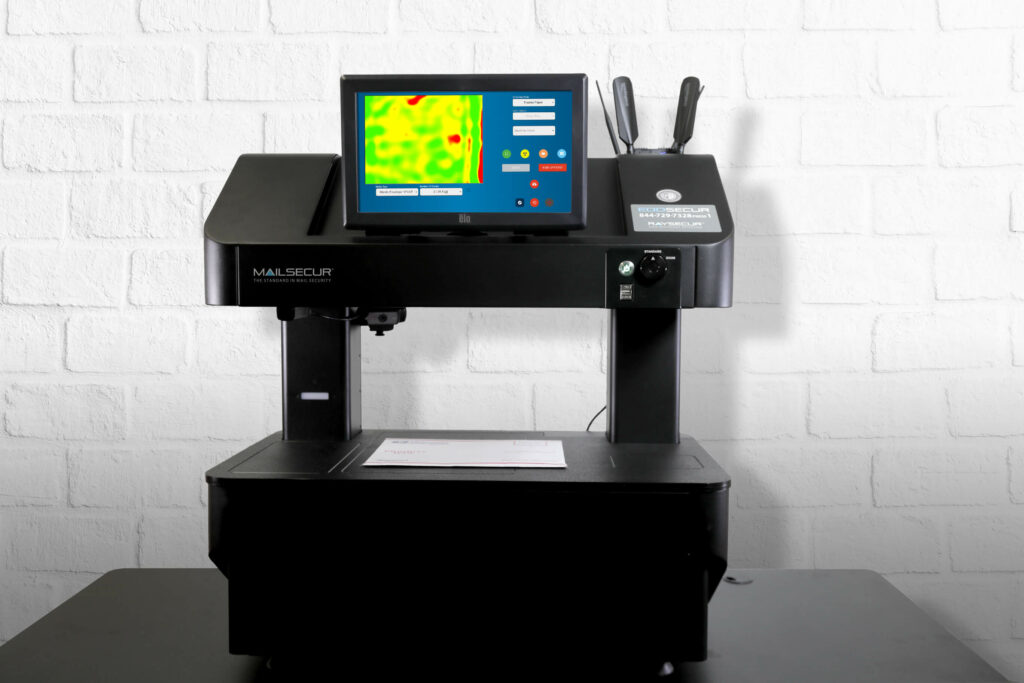
Smugglers Find New Ways to
Conceal Drugs in Mail and More
Drug detection becomes more difficult with drug-laced paper, suboxone strips, and smaller quantities of powders. Oftentimes, mail can be a top method for smuggling contraband into corrections facilities with suboxone strips behind stamps and return labels or tiny amounts of powders concealed in letters, magazines, or small packages.
Today’s existing screening methods for drugs in the mail and other areas within facilities, such as physical inspections, X-ray scanning, lightboxes, and canine units, often fail to detect them. This allows these types of synthetics, chemical intoxicants, and drugs to flow into jails and prisons. It’s already a problem and one that will only get worse as inmates and their conspirators employ even more innovative ways to conceal illicit and dangerous substances in the mail.
EXISTING DRUG SCREENING SHORTCOMINGS
Why Are Drugs and Intoxicant Substances So Difficult to Detect?
Screening techniques currently used and once accepted as the best way to detect drugs and contraband simply can’t keep up. Traditional drug detection devices aren’t optimized, nor scalable to keep up with the new ways criminals are smuggling drugs and contraband.
For instance, the most recent, and prevalent method, of smuggling intoxicants and drugs in the mail is spraying or soaking paper with liquids containing synthetic cannabinoids known as K2, K3, or spice. Once the paper has dried, these treated or drug-laced papers may be indistinguishable from normal paper. In the mail, these substances are very difficult to detect with the human eye or conventional mail screening processes.
In the case of powder or liquid synthetic drugs in the mail, the increased potency of new drugs, including fentanyl, ISO, and related substances, makes a tiny amount go a long way. They are often sent in such small quantities that conventional drug detection screening technologies are unable to determine their presence. Opening mail containing drugs or other substances also poses a significant health and safety risk to corrections staff and inmates.

DETECTING DRUG-TREATED PAPER
Without Opening the Mail.
Quickly scan and clear normal letters, parcels or documents, while flagging suspicious items for further investigation.
Superior Drug and Narcotic Detection Capabilities
MailSecur provides a live 3D video of the contents inside of a sealed mail item. These images are 300x more sensitive than X-rays and detect small quantities of liquids, powders, and other drugs. This advanced imaging capability is built on safe T-ray technology that allows operators to freely manipulate the objects to gain alternate views for a detailed inspection in a matter of seconds. This approach is markedly different from existing screening technologies for drug detection, like X-ray, which uses harmful radiation and requires specialized training and certification to interpret the 2D scans accurately.




MailSecur Detects:
Treated Papers
K2/K3, spice, methamphetamines, fentanyl,THC, Raid, and other narcotics and chemical compounds
Suboxone Strips
Concealed in letters, magazines, newspapers, and behind stamps and return labels
Powder or Liquid Forms
Methamphetamines, fentanyl, opioids, cocaine, heroin, synthetic marijuana, tobacco, and other related substances
Emerging Threats
As drug compounds and smuggling methods continue to evolve, MailSecur keeps pace with emerging threats through updates to software and training
MAILSECUR ADVANTAGE
Overcome Challenges
of Conventional Screening Approaches
With MailSecur, corrections officers and screening staff can use safe T-ray technology to “see inside” the mail and move through the screening process much faster while also drastically reducing the risk of staff exposure to drugs in the mail since the items don’t need to be opened for screening.
The operator sees a live 3D video of the internal contents to detect drugs in the mail, including drug-treated papers, and small quantities of liquids, powders, and other drugs. This advanced imaging capability is built on safe T-ray technology that allows operators to freely manipulate the objects to gain alternate views for a detailed inspection in a matter of seconds.
Once accepted as the best way to detect drugs in the mail, they are now limited in their effectiveness:
- Manual inspections – expose staff to harmful substances
- Copying or digitizing – raises legal challenges, particularly for privileged and legal mail
- X-ray – lacks sensitivity to detect small quantities of drugs, powders, liquids, and laced–papers
- Lightboxes – limited effectiveness and generally requires the mail to be opened
- Canine units – difficult to keep pace with changes in drug compounds and exposes animals to risks from fentanyl and other harmful substances

